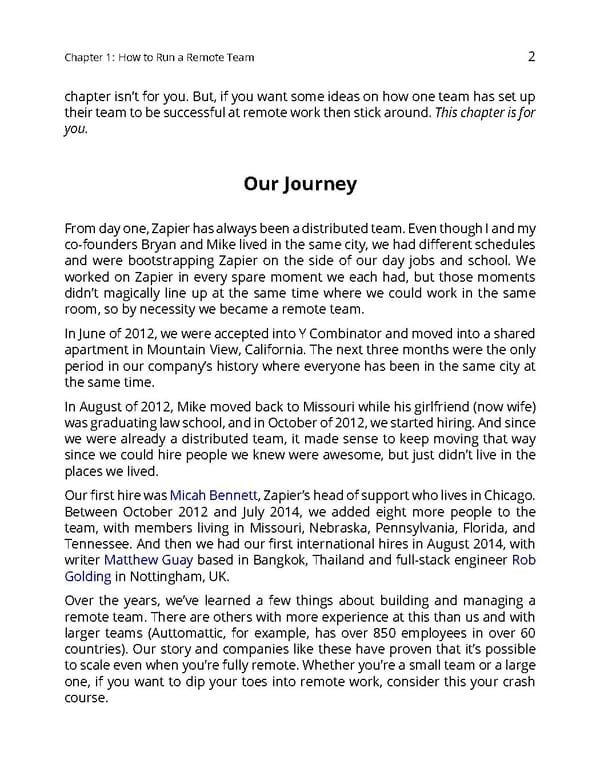Chapter1: HowtoRunaRemoteTeam 2 chapter isn’t for you. But, if you want some ideas on how one team has set up theirteamtobesuccessfulatremoteworkthenstickaround.Thischapterisfor you. OurJourney Fromdayone,Zapierhasalwaysbeenadistributedteam.EventhoughIandmy co-foundersBryanandMikelivedinthesamecity,wehaddifferentschedules and were bootstrapping Zapier on the side of our day jobs and school. We worked on Zapier in every spare moment we each had, but those moments didn’t magically line up at the same time where we could work in the same room,sobynecessitywebecamearemoteteam. In June of 2012, we were acceptedintoYCombinatorandmovedintoashared apartmentinMountainView,California. The next three months were the only period in our company’s history where everyone has been in the same city at the sametime. In August of 2012, Mike moved back to Missouri while his girlfriend (now wife) wasgraduatinglawschool,andinOctoberof2012,westartedhiring.Andsince we were already a distributed team, it made sense to keep moving that way since we could hire people we knew were awesome, but just didn’t live in the places we lived. OurfirsthirewasMicahBennett,Zapier’sheadofsupportwholivesinChicago. Between October 2012 and July 2014, we added eight more people to the team, with members living in Missouri, Nebraska, Pennsylvania, Florida, and Tennessee. And then we had our first international hires in August 2014, with writer Matthew Guay based in Bangkok, Thailand and full-stack engineer Rob Golding in Nottingham, UK. Over the years, we’ve learned a few things about building and managing a remoteteam.Thereareotherswithmoreexperienceatthisthanusandwith larger teams (Auttomattic, for example, has over 850 employees in over 60 countries). Our story and companies like these have proven that it’s possible toscaleevenwhenyou’refullyremote.Whetheryou’reasmallteamoralarge one, if you want to dip your toes into remote work, consider this your crash course.
 The Ultimate Guide to Remote Work Page 5 Page 7
The Ultimate Guide to Remote Work Page 5 Page 7